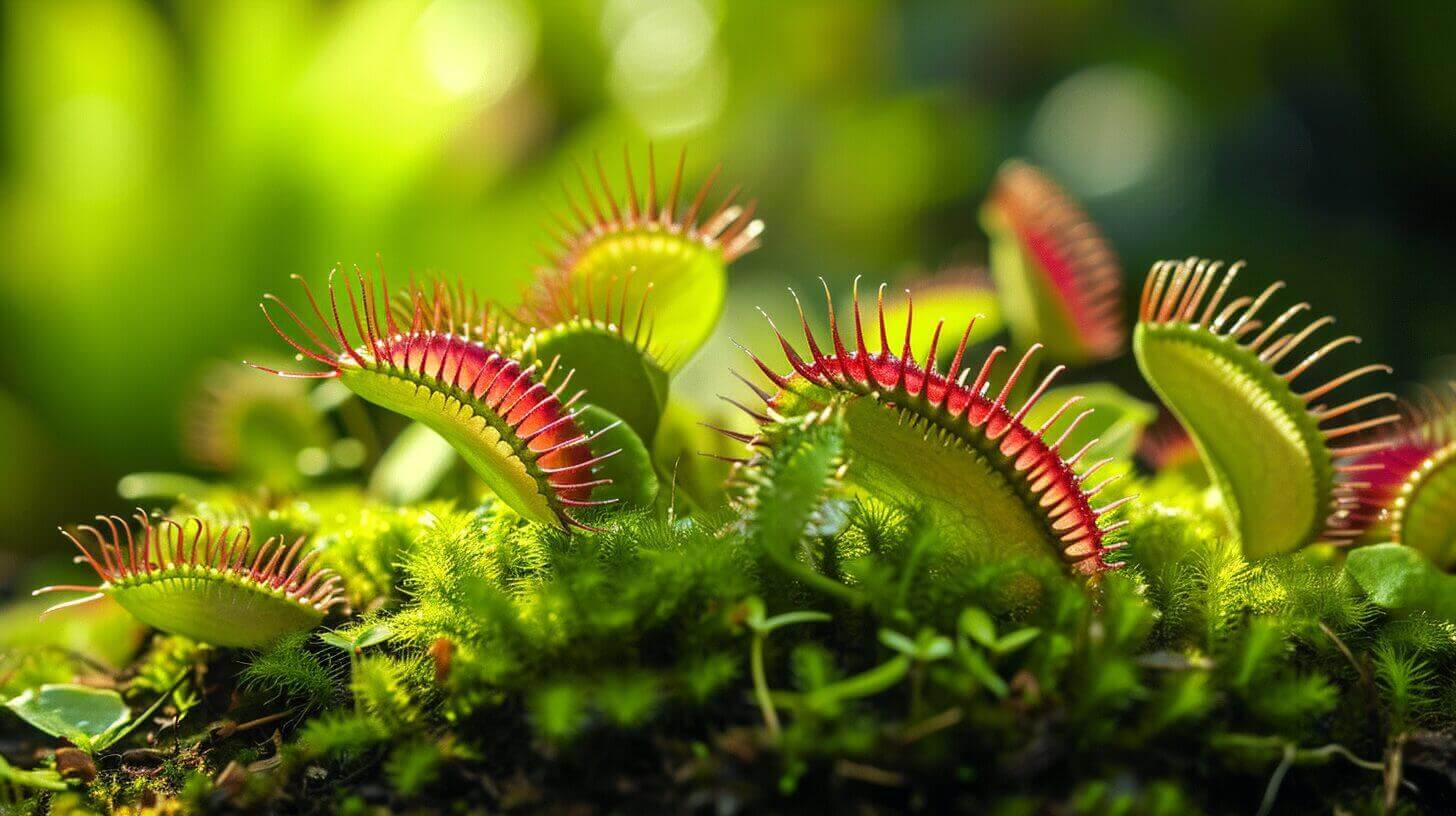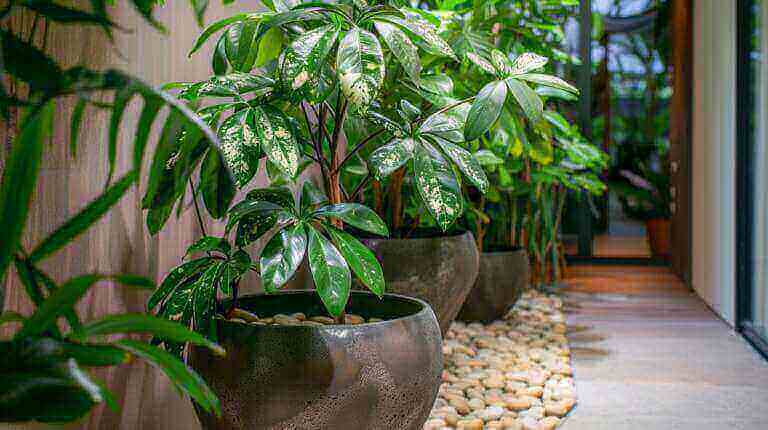Venus Flytrap Carnivorous Plant Habitat: How to Recreate Their Natural Environment Indoors
These captivating plants are native to the coasts of North and South Carolina, specifically found within a 75-mile radius of Wilmington, North Carolina. However, due to their threatened status, it is illegal to gather them from the wild.
But worry not! You can still enjoy the beauty and wonder of Venus flytraps by recreating their natural habitat indoors. In this article, I will guide you on how to provide them with the perfect environment to thrive within the comfort of your own home.
Key Takeaways:
- Recreating the Venus flytrap habitat indoors ensures their well-being and survival.
- Venus flytraps thrive in moist, acidic soils and require adequate lighting, humidity, and watering.
- Placing them near a window for direct sunlight or using artificial grow lights can fulfill their lighting requirements.
- Creating a well-draining and acidic soil mixture is crucial for their healthy growth.
- Maintaining proper humidity levels through misting and bottom-watering techniques is essential.
Choosing the Right Container
When recreating the habitat for your Venus Flytrap indoors, it is important to choose the right container. This will ensure that your carnivorous plant thrives and remains healthy.
Selecting a Suitable Container for Your Indoor Venus Flytrap Habitat
The container you choose should be open and dish-like in shape. This allows for proper air circulation and prevents the trapping of excess humidity. An open top terrarium is a good option as it helps trap humidity in the surrounding walls.
It is best to avoid using terra-cotta pots, unless they are glazed. Unsealed terra-cotta pots can lead to excessive moisture evaporation, which can be detrimental to the health of your Venus Flytrap. Instead, consider containers made of plastic, glazed ceramic, or resin. These materials are durable and retain moisture better, providing a suitable environment for your plant.
Determining the Appropriate Size and Material for the Container
When selecting the size of the container, it is better to err on the side of caution and choose a slightly larger one. Venus Flytraps have a root system that requires ample space to grow. Providing enough room for the roots to spread out will support the overall health and development of the plant.
As for the material, plastic, glazed ceramic, and resin are all solid options. These materials are sturdy and can withstand the humidity levels that the Venus Flytrap requires. Make sure that the chosen material is capable of retaining moisture without becoming overly saturated.
Creating the Ideal Soil Mix
When recreating the habitat for your Venus Flytrap indoors, the soil mix plays a crucial role in providing the necessary nutrients and conditions for the plant to thrive. It is important to understand the specific soil requirements for Venus Flytrap plants and mix the right combination of ingredients for the soil mix.
Understanding the specific soil requirements for Venus Flytrap plants
Venus Flytraps are native to nutrient-poor environments, such as bogs and wetlands. Therefore, it is essential to create soil that mimics these conditions. Regular potting soil or enriched soil should be avoided, as they contain too many nutrients that can burn the roots of the Venus Flytrap and lead to its demise.
The ideal soil mix for Venus Flytraps is a 50/50 ratio of peat to sand. This ratio provides the necessary acidity and drainage that these plants need. Peat moss has a high acidity level, which mimics the acidic environment of their natural habitats. Sand, on the other hand, improves drainage and prevents waterlogging, which can be harmful to the roots.
Mixing the right combination of ingredients for the soil mix
To create the ideal soil mix, start by moistening the peat moss. Add water and stir until the peat moss is thoroughly soaked. Then, slowly mix in the sand. The sand should be well-distributed throughout the peat moss to ensure proper drainage and aeration.
It is important to note that the measurements for the soil mix are based on volume, not weight. Mixing equal volumes of peat moss and sand will ensure the right balance for your Venus Flytrap’s soil.
Once the soil mix is ready, it is time to choose the right container for your indoor Venus Flytrap habitat. The container should be open and dish-like in shape to allow for proper air circulation and prevent excessive humidity. Materials such as plastic, glazed ceramic, or resin are recommended as they retain moisture better and provide a suitable environment for your plant.
Providing the Proper Lighting Conditions
Exploring the ideal lighting conditions for Venus Flytraps
To recreate the natural habitat of Venus Flytraps indoors, it is crucial to provide them with the proper lighting conditions. These carnivorous plants thrive under full sun or very strong artificial light. Adequate lighting is essential for the Venus Flytrap’s photosynthesis process, which is crucial for its growth and health.
Venus Flytraps are native to the Carolina coastal plain, where they receive abundant sunlight. Therefore, it is important to mimic these lighting conditions when growing them indoors. Full-spectrum LED lights are an excellent choice as they provide the full spectrum of light that the plant needs. These lights should be positioned as close to the plant as possible. Ideally, the Venus Flytrap should be placed about 2 inches away from the light source.
Choosing between natural sunlight and artificial lighting options
If you have a sunny spot in your home where the Venus Flytrap can receive direct sunlight for at least six hours a day, natural sunlight can be a great option. However, it is essential to monitor the temperature and humidity levels to ensure they remain within the acceptable range for the plant’s well-being.
For those who do not have access to sufficient natural sunlight, artificial lighting can be a suitable alternative. Compact fluorescent bulbs are an economical choice for this purpose. They should be positioned close to the Venus Flytrap, providing the necessary intensity of light.
Maintaining Ideal Temperature and Humidity
Understanding the temperature and humidity preferences of Venus Flytrap plants
To recreate the natural habitat of Venus Flytrap plants indoors, it is crucial to understand their temperature and humidity preferences. These carnivorous plants are native to the wetlands of the Carolina coastal plain, where they experience warm temperatures and high humidity levels.
Venus Flytraps thrive in temperatures between 70°F (21°C) and 90°F (32°C). It is important to avoid extreme temperatures, as they can harm the plants. High temperatures above 100°F (38°C) can cause the leaves to wilt and potentially damage the plant, while temperatures below freezing can lead to the death of the plant.
In terms of humidity, Venus Flytraps prefer a high level of humidity, ideally between 50% and 70%. This mimics the conditions in their natural environment. High humidity helps to keep the plants hydrated and assists in the digestion process after capturing prey.
Implementing strategies to create the ideal indoor environment
To maintain the ideal temperature and humidity for Venus Flytrap plants indoors, there are several strategies you can implement.
If the surrounding environment is dry, consider using a humidifier to increase the humidity levels around the plant. This can help prevent the leaves from drying out and enhance their overall health. Alternatively, you can use the water tray method by placing a tray filled with water at the base of your plant. As the water evaporates, it increases the humidity around the plant.
Monitoring the temperature is also crucial. Ensure that the temperature does not exceed 100°F (38°C) or drop below 32°F (0°C) at any time. If necessary, adjust the temperature using heaters or air conditioning to maintain the optimal range.
Watering and Feeding
Learning the proper watering techniques for Venus Flytraps
When it comes to watering Venus Fly trap houseplants, it is important to replicate the moist and wet conditions they thrive in their natural habitat. These carnivorous plants are native to boggy regions, where the soil is constantly saturated with water.
To recreate this environment indoors, it is crucial to keep the growing medium consistently moist to wet at all times. Avoid allowing the soil to dry out, as this can cause stress and damage to the plant. Venus Flytraps rely on the moisture in the soil to survive and capture prey effectively.
One recommended method of watering is by sitting the base of the Venus Flytrap pot in a saucer of water for a few hours every few days. This allows the plant to soak up the water it needs. Some growers also leave the pot sitting in a saucer with a small amount of water at all times, although this method should be monitored closely to prevent the risk of root rot.
Feeding the plants with appropriate prey or using alternative methods
In their natural habitat, Venus Flytraps capture and digest insects to obtain the necessary nutrients they require. However, if you are growing these plants indoors or in an area with a limited supply of insects, you may need to provide them with alternative sources of food.
One option is to feed your Venus Flytrap small insects such as fruit flies or ants. These can be offered to the plant by carefully placing them on the trigger hairs of the trap. The trap will then close, and the plant will begin the digestion process.
Alternatively, if you are unable to provide live prey, you can supplement the plant’s diet with commercial insect food or nutrients specifically formulated for carnivorous plants. These are available in both liquid and pellet form and can be mixed with water and applied to the soil or sprayed directly onto the traps.
By following the proper watering techniques and feeding your Venus Flytrap with appropriate prey or alternative methods, you can ensure that your carnivorous plant receives the necessary care it needs to thrive indoors.
FAQ
How do I care for a Venus Flytrap indoors?
Caring for a Venus Flytrap indoors involves providing the right growing conditions. These plants need a lot of light, so a sunny windowsill or a spot under artificial light is ideal. They also require high humidity and prefer distilled water over tap water.
What type of pot is suitable for a Venus Flytrap?
A plastic pot is often recommended for Venus Flytraps. It’s important to ensure the pot has good drainage as these plants don’t like to sit in water.
What is the role of dormancy in the life of a Venus Flytrap?
Dormancy is a crucial period of rest for the Venus Flytrap, similar to winter dormancy in many outdoor plants. During this time, growth slows down and the plant conserves energy.
Why does my Venus Flytrap turn black?
If parts of your Venus Flytrap turn black, it could be a sign of overwatering, disease, or that a trap has used up its energy reserves after catching prey. Traps will naturally die off and turn black after a few successful catches.
What should I feed my Venus Flytrap?
In the wild, Venus Flytraps catch small insects and spiders. If you’re growing them indoors, they can be fed small insects. However, they can also get nutrients from photosynthesis and may not need to be fed if they’re getting enough light.
Can I grow other carnivorous plants with my Venus Flytrap?
Yes, Venus Flytraps can be grown with other carnivorous plants like Sundews and Pitcher Plants. They all enjoy similar growing conditions and can make for an interesting indoor bog garden.







